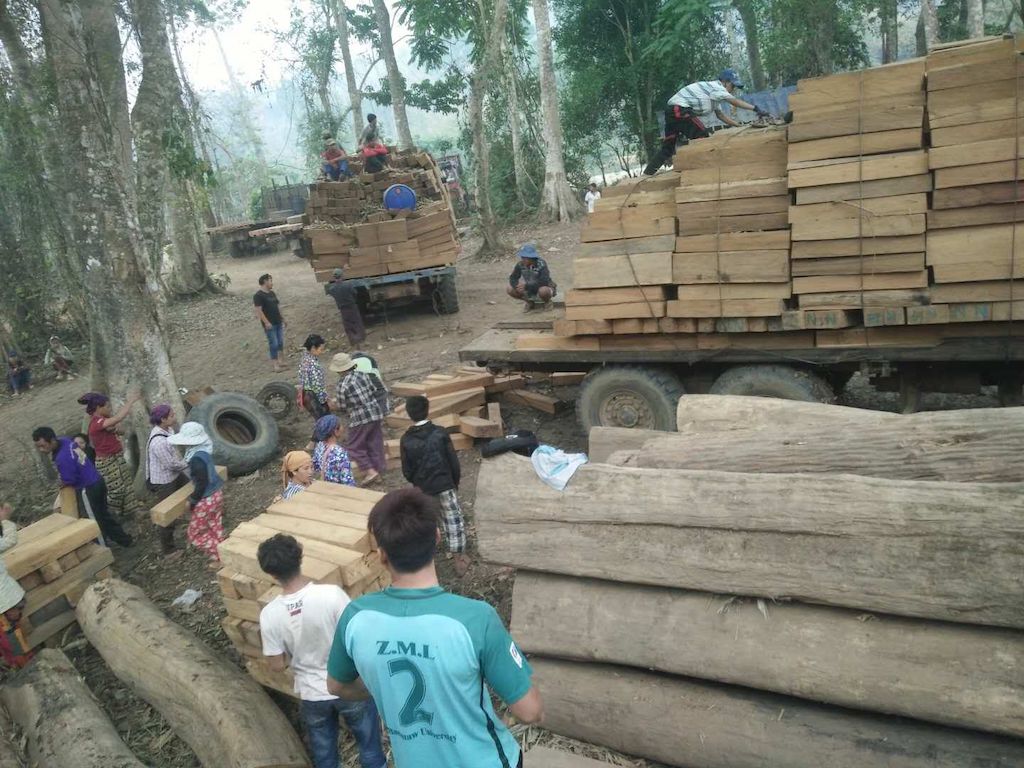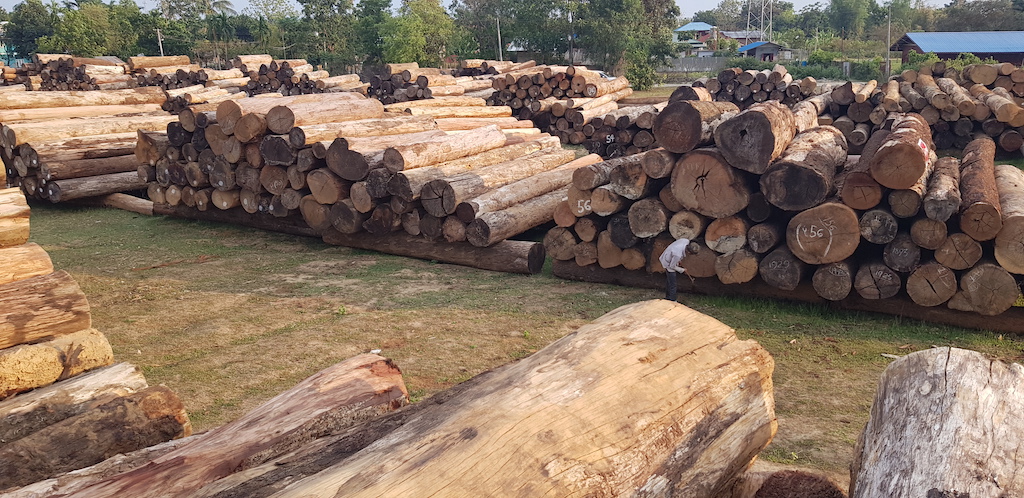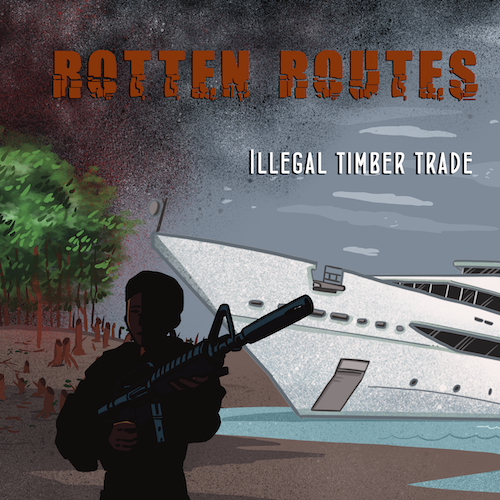
31 Mar Italy’s addiction to teak from Myanmar
Italy has become Europe’s top importer of Burmese teak, even after the coup in Myanmar, helping to fund the military regime and encourage deforestation. Rudi Bressa investigates

A collection site for timber harvested in Myanmar in 2018. Photo © Environmental Investigation Agency
“It works like a drug: it always finds a way,” says Alessandro Calcaterra, president of the Italian association of wood importers, Fedecomlegno.
Calcaterra has been working in the wood trade for generations and over the years, along with the national association, he has been following the evolution of the complicated situation around “Burmese teak” – the luxury hardwood coming from Myanmar. “We are talking about one of the most expensive woods in the world, it triggers some mechanisms similar to smuggling.”
During recent years production lines have grown in the nautical and decking industries. Teak is considered the king of the woods in these industries. It’s a native species in South Asia, where Indonesia and Myanmar have become the world’s largest suppliers. It has a pleasant appearance and colour, and is prized for its durability against atmospheric conditions and degrading agents.
For these reasons it has been the pillar of the shipbuilding industry for centuries and is also used for the production of flooring, cabinets and fine furniture. It’s the best material for ship and yacht decks: the trunks are carefully selected and the ones that are going to be used are “the crème de la crème, the best selection of logs, which can be more than 100 years old”, Calcaterra says.
Over the years Italy has obtained an almost unique role in the importation in Europe for this raw material. According to the non-governmental organisation Environmental Investigation Agency (EIA), which for many years has monitored trade in timber from Myanmar, Italy has been increasingly dominating this trade. In a report titled The Italian job, the organisation shows how the country imported almost €24-million of wood products in 2020 – representing 66% of the total timber importations from Myanmar to Europe.
“Italy has been an important player for a long time,” says Faith Doherty, head of the EIA forest section. “It’s not an isolated case, but a long-term relationship with the [Burmese] timber sellers.”
Calcaterra confirms this: “As North European countries cut down the importations, so Italy’s role as importer has grown.”
Once the goods enter the market, they are able to circulate freely, Calcaterra explains. “Italy has a very strong position about the teak from Myanmar – that it is needed almost exclusively for decks for sailboats, holiday cruisers and yachts,” he says.

Felled logs in Kachin State in northern Myanmar in May 2020. Photo © Environmental Investigation Agency
Illegal wood
This trade is happening in contravention of European Commission recommendations, in particular the regulation known as the European Union Timber Regulation (EUTR), set up in 2013 to prohibit the placing in the market of illicit cut timber, or of products made from illegal wood. This regulation requires timber operators to exercise due diligence when sourcing timber and to verify its legality.
“Before the coup in Myanmar, there were some laws that may have helped the sustainable cut and trade,” Doherty says. “However, according to our monitoring and documentation, we can say that these laws were never put into practice.”
In 2017 the EUTR group of experts concluded it was “impossible for any verifying service to mitigate the risk, to a negligible level, that the Myanmar timber was collected illegally”.
In 2020 the same group concluded “for all the Myanmar timber the risk that it was collected illegally is not negligible”, and the operators couldn’t “use mitigation proceedings”.
Eurostat records
So why has Italy continued to import timber from Myanmar? According to Alessandra Stefani, general director at the Ministry of Agricultural, Food and Forestry Policies (Mipaaf), “until 2021 the European Union didn’t take a clear position, so we only could write to the companies involved to activate clear proceedings for importation. Three-quarters of the Italian companies let it go [stopped importing Burmese teak], but 25% unfortunately has continued and has imported as much as the others have not.”
Data collated by #WildEye shows Italy continued to import timber from Myanmar during 2021, though there was a downturn in volumes after the communication was put out by the Mipaaf last May.
Records from Eurostat, the statistics office of the EU, show that from January to November 2021, Italy reported importing 19,000kg of teak from Myanmar. Imports decreased from June 2021, after regulation Eu 2021/998 clamped down on the Myanmar Timber Enterprise (MTE) – the state company in charge of the sale of wood – effectively forbidding trade with government bodies connected to the Myanmar regime.
Says a spokesperson for one of the Italian timber operators, Timberlux SRL: “The EUTR regulation provides for activating risk assessment proceedings that allow the importer to assess the risk that the timber has legal sources. These proceedings consider several variables, among them the prevalence of armed conflicts in the exporting country. Considering that I am not able to mitigate the risk from a coup d’état, I decided not to import any more material exported from Myanmar. The situation has become even more drastic after the European sanction of last June.”

Many yachts and luxury yachts in circulation have decks crafted out of Burmese teak. Photo © Canva
Full warehouse
So why even after June 2021 did teak continue to arrive in Italy, though the amount imported is lower? “Both the EUTR regulation and Eu 2021/998 do not forbid in particular the importation of Burmese teak, otherwise customs would be the first to stop the material when it comes to the port,” the Timberlux spokesperson says. “Therefore it concerns using proceedings to mitigate the risk and to trace chains of custody. However, my company policy has been to decide stopping importations from Myanmar.”
A similar denial comes from Fabrizia Comisso, representative of timber importing company Cominlegno Srl: “We have never broken the sanctions and our suppliers have never had contacts with the regime. The company is absolutely not controlled by MTE,” he says, adding that “after the coup d’état we asked our supplier to send us some material that it had already paid for to MTE – so it’s not sanctioned material.”
However, the teak demand has not stopped. “There is someone who still does’t want to give it up and who declares to have bought it before, but he will have to prove it when the inspection is done”, says Stefani at the ministry. “We are aware of a full warehouse, but companies are reluctant to put the wood in the market. This is already a small achievement, because the companies that imported it have to prove several things, which are not easy to carry out.”
Many yachts and luxury yachts in circulation have been built using Burmese teak, encouraging deforestation in Myanmar, which has already lost one-third of its forests and is a country that is compromised in terms of its political and humanitarian situation. Nevertheless, the wood is continuing to circulate because “what a billionaire wants, a billionaire gets”, Doherty concludes.

This investigation by Italian journalist and Oxpeckers Associate Rudi Bressa is part of a series of cross-border data-driven investigations into how the illegal teak trade from Myanmar to Europe is fuelling deforestation and propping up Myanmar’s military regime. You can follow the Rotten Routes project here.
The investigation was produced with support by a grant from the Investigative Journalism for Europe (IJ4EU) fund, and was a collaboration with #WildEye, sponsored by Oxpeckers Investigative Environmental Journalism and the Earth Journalism Network. The investigation was published in Italy by Domani here.
You can follow illegal timber and other environmental crime incidents in Europe and Asia on our #WildEye tracking tools
